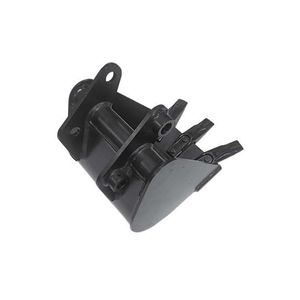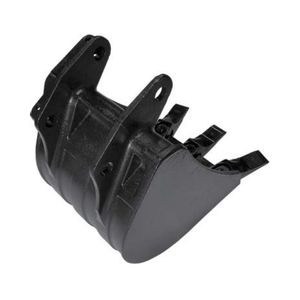
Case Study: Compact Utility Tractor
First Cast-Iron Backhoe Bucket on the Market
Waupaca Foundry aided in the redesign and launch of the first-to-market cast iron bucket attachment for a compact utility tractor attachment OEM. After an innovative and collaborative design and problem-solving process, the resulting backhoe bucket and teeth are more durable, cost-effective, and made in the United States.
Steel fabricated buckets are strong but run the risk of breaking at the weld seams. The OEM sought a supply chain that could cast, machine, paint and assemble the new cast bucket and bucket teeth. The existing fabricated bucket is composed of nine parts welded together with 159 inches of weldment. The intent was to localize supply in an effort to localize production. (Note that the bucket was produced stateside and the teeth were made in China.)
Internally, Waupaca also needed to coordinate casting production efforts between two locations, over 100 miles apart, which had never been done before.
The WF team first ran MAGMA tests, which showed minimal concern for porosity in both the buck and the bucket teeth. Finite element analysis (FEA) proved the casting to be a better solution than the current steel weldment.
Several design and feasibility meetings followed to determine the engineering parameters required to achieve optimal efficiencies and final performance.
MAGMA tests were ran, which showed minimal concern for porosity in both the bucket and the bucket teeth. Finite element analysis (FEA) proved the casting to be a better solution than the current steel weldment.
Several design and feasibility meetings followed to determine the engineering parameters required to achieve optimal efficiencies and final performance.
Working off of a model supplied by the customer, Waupaca Foundry engineering created a bucket design that could be produced as an iron casting. In contrast to a steel fabricated bucket, a cast iron bucket can be designed to include a slightly wider opening, allowing scooped material to more easily fall out of the bucket. Even with this tapered design, the bucket did not sacrifice volume.
The bucket teeth also presented a design challenge. Because a backhoe’s bucket teeth take the brunt of the impact while the bucket is in use, they are periodically replaced. By adding a slight flare to the design, it allowed the wedge-shaped teeth to slide on and off for easy replacement.
Further, a pattern with four cores is capable of producing 16 teeth in a single mold, resulting in cost and time savings. The teeth are then heat-treated prior to assembly to increase hardness and obtain maximum strength and durability. Each bucket features three teeth.
Teams at two different locations coordinate production of the bucket and teeth with frequent communication to ensure the profile tolerance and design fit between the Tell City, IN and Marinette, WI foundries.
Waupaca Foundry manages the supply chain for the bucket, including casting, machining, heat treatment, assembly, and paint.

BEFORE: Nine parts fabricated with 159 inches of weldment.

AFTER: Single cast iron bucket and three assembled cast iron teeth
Both the OEM and its machining partner are pleased with the collaboration and strategic partnership created with this project.
“Waupaca Foundry regards the customer as a team member,” said Senior Project Engineer Terry S. “They guided us throughout the process and took on the challenge of doing ‘more’ - we welcome that here.”
Because of the collaboration, the customer is under less pressure in a tight labor market having reduced the need for in-house welding and assembly. The client also saves labor costs and simplifies its supply chain with this partnership.
A cast iron bucket is advantageous in the manufacturing process for several reasons:
- It’s a more efficient use of capacity and materials.
- The pin alignment is more precise and allows the bucket to be more easily assembled.
Finally, as we consider the residential users of the finished product, users of these utility tractors enjoy:
- Reliability—The bucket features no weld seams, reducing the risk of breakage and increasing durability.
- Longevity—The teeth perform up to 250 hours of rigorous work before replacement may be necessary
- Presentation—A heavy duty appearance that gives confidence in its robust performance
